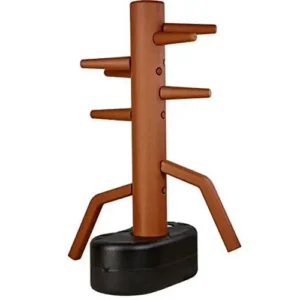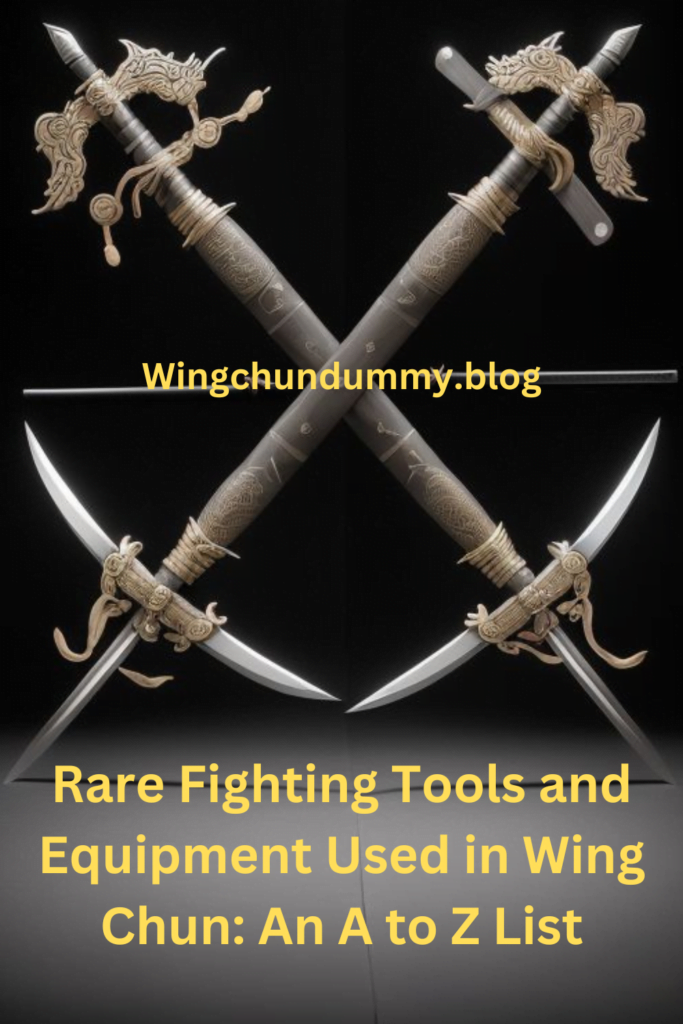Wing Chun (Rare Fighting Tools), a traditional Chinese martial art, traces its origins back to the Southern Shaolin Monastery.
Developed around 300 years ago, this fighting style is attributed to the legendary Buddhist nun Ng Mui and her disciple Yim Wing Chun, after whom the art is named.
Unlike many martial arts that emphasize brute strength, Wing Chun focuses on efficiency, directness, and practicality.
It utilizes the principle of economy of motion, allowing practitioners to neutralize opponents with minimal effort.
The core principles of Wing Chun revolve around concepts such as centerline theory, simultaneous attack and defense, and sensitivity training.
These principles are integral to its unique training methods, which often involve specialized tools and equipment.
The use of these tools is not merely traditional but serves a functional role in honing the specific skills and techniques that define Wing Chun.
They help practitioners develop precise movements, structural alignment, and tactile sensitivity, which are crucial for effective practice.
Among the most recognizable tools in Wing Chun are the wooden dummy (Muk Yan Jong) and butterfly swords (Baat Jaam Do).
The wooden dummy, a wooden post with protruding arms and legs, is used to simulate an opponent, allowing practitioners to perfect their angles, positioning, and timing.
Butterfly swords, short and broad blades, are designed for close-range combat, aligning with Wing Chun’s focus on in-fighting techniques.
Additionally, other less common but equally important tools include the long pole (Luk Dim Boon Kwun) and wall bags for striking practice.
These specialized tools and equipment not only distinguish Wing Chun from other martial arts but also provide a comprehensive training platform that integrates physical conditioning with technical proficiency.
Through the consistent use of such equipment, practitioners can internalize the fundamental principles of Wing Chun, ensuring that their skills are both effective and grounded in the art’s rich tradition.
The Butterfly Swords, or Baat Jaam Do, hold a prestigious place in the realm of Wing Chun.
Renowned for their distinctive design, these short, broad-bladed weapons are typically used in pairs.
Each sword features a robust guard and a blade that widens towards the tip, facilitating both cutting and thrusting actions.
Historically, the Butterfly Swords were crafted for close-quarter combat, making them well-suited for the rapid, fluid movements characteristic of Wing Chun.
From a historical perspective, the Butterfly Swords have their origins in Southern China, where they were employed by martial artists and militia alike.
Their design reflects the practical needs of the time, emphasizing portability and versatility.
The swords were not only tools of war but also instruments for training, ingraining principles of Wing Chun into the practitioner’s muscle memory.
Over time, the Baat Jaam Do became a symbol of the martial art itself, embodying both its rich heritage and sophisticated techniques.
In terms of techniques, the Butterfly Swords are integral to mastering several key aspects of Wing Chun.
The swords are used to practice precise, controlled movements that enhance a practitioner’s skill in both offense and defense.
Techniques such as the “chop,” “thrust,” and “block” are execute with a focus on efficiency and speed.
The weight and balance of the Butterfly Swords demand a heightened sense of coordination and timing, pushing practitioners to refine their skills continually.

Moreover, training with the Butterfly Swords offers significant benefits beyond mere combat proficiency.
It aids in developing a practitioner’s spatial awareness, agility, and reflexes.
The dual-wielding nature of the swords requires ambidexterity.
Promoting balance muscle development and improving overall physical conditioning.
By integrating the use of Butterfly Swords into their training regimen.
Practitioners can achieve a harmonious blend of power and precision, hallmarks of the Wing Chun martial art.
The Wooden Dummy, known as Muk Yan Jong in Cantonese, is a pivotal training apparatus in Wing Chun martial arts.
This tool is designe to replicate an opponent, allowing practitioners to refine their techniques in a controlled environment.
Structurally, the Wooden Dummy consists of a cylindrical trunk, typically made of hardwood, with three protruding arms and a leg.
These elements are strategically positioned to mimic an opponent’s limbs, offering a realistic target for strikes and blocks.
The primary purpose of the Wooden Dummy is to enhance a practitioner’s form, precision, and reflexes.
By practicing on the dummy, students can develop a deeper understanding of distance, timing, and angles, which are crucial components in Wing Chun.
The resistance provide by the Wooden Dummy also helps to strengthen the muscles and tendons, contributing to overall physical conditioning.
Practitioners engage with the Wooden Dummy through a series of forms and drills known as Muk Yan Jong forms.
These forms consist of pre-arrange sequences of movements that encompass various strikes, blocks, and footwork patterns.
Each movement is designed to simulate real combat scenarios, allowing practitioners to internalize the techniques and responses required in actual confrontation.
One of the key benefits of training with the Wooden Dummy is the improvement of structural integrity and alignment.
By repeatedly practicing forms, students can ensure that their stances and positions are correct,
reducing the risk of injury and increasing the effectiveness of their techniques.
Additionally, the dummy provides immediate feedback;
any deviation from proper technique is felt through the resistance, prompting immediate correction.
The drills associate with the Wooden Dummy are not limited to solo practice.
Instructors often incorporate these drills into partner exercises.
Further enhancing the practitioner’s ability to apply Wing Chun principles in dynamic and unpredictable situations.
The Wooden Dummy, therefore, serves as an indispensable tool for both novice and advance practitioners.
Bridging the gap between theoretical knowledge and practical application in Wing Chun martial arts.
Wall Bag (Sandbag)
The Wall Bag, also known as the Sandbag, is an essential training apparatus in Wing Chun.
Playing a crucial role in conditioning the hands and enhancing striking power.
These bags are typically constructed from durable canvas or leather and are filled with various materials such as sand, rice, or beans to provide varying degrees of resistance and impact hardness.
The Wall Bag is often mounted on a sturdy wall or wooden frame.
Allowing practitioners to practice their strikes with precision and intensity.
There are several variations of Wall Bags used in Wing Chun training.
The most common type features multiple compartments.
Each filled with a different material to progressively challenge the practitioner.
This design allows for incremental hand conditioning.
Starting from softer fillings like rice and advancing to harder materials like sand or steel shot.
Some Wall Bags also incorporate target zones to help practitioners focus on accuracy and technique.
The primary purpose of the Wall Bag in Wing Chun is to develop striking power and hand conditioning.
Through repeated strikes, practitioners toughen their knuckles, wrists, and forearms, reducing the risk of injury during actual combat.
Additionally, the repetitive nature of the training helps in fine-tuning the mechanics of various strikes.
Ensuring they are delivered with maximum efficiency and force.
The feedback provided by the Wall Bag’s resistance aids in perfecting the alignment and structure of the practitioner’s strikes.
Incorporating the Wall Bag into daily training routines is a common practice among Wing Chun practitioners.
Training sessions often begin with a warm-up, followed by focus striking drills on the Wall Bag.
This not only aids in physical conditioning but also reinforces mental discipline and focus.
Over time, consistent use of the Wall Bag results in significant improvements in striking power, accuracy.
And overall martial prowess, making it a cornerstone of Wing Chun training.
Long Pole (Luk Dim Boon Kwun)
The Long Pole, known as Luk Dim Boon Kwun, is a pivotal tool in the Wing Chun martial arts system.
Measuring approximately 8 to 13 feet in length.
The Long Pole is crafted from hardwood.
Providing both durability and the necessary weight for effective training.
This tool is not just a weapon but also a means to develop core Wing Chun principles such as strength, balance, and coordination.
Training with the Long Pole involves mastering specific techniques and forms, most notably the “Six and a Half Point Pole” form.
This form is characterizing by its emphasis on precision and control, requiring practitioners to execute a series of thrusts, sweeps, and strikes with exacting accuracy.
The pole’s extended reach allows for the practice of long-range attacks and defenses.
Which contrasts with the typically close-quarter combat strategies of Wing Chun.

Enhancing physical attributes is a significant benefit of training with the Long Pole.
The weight and length of the pole demand considerable upper body strength and stamina.
Additionally, the practice develops fine motor skills and hand-eye coordination, as well as improving one’s balance and stability.
These attributes are crucial for executing Wing Chun techniques effectively and with fluidity.
Historically, the Long Pole has held considerable significance within the Wing Chun tradition.
It was used by practitioners not only as a weapon but also as a tool for physical and mental conditioning.
The pole’s use dates back to the origins of Wing Chun.
where it was employed by warriors to enhance their combat skills and prepare for battle.
Practical applications of the Long Pole extend beyond traditional martial arts practice.
In modern self-defense scenarios, the principles learned from Long Pole training can be adapt to everyday objects of similar shape and size.
Making it a versatile component of Wing Chun’s comprehensive training system.
Rattan Rings

Rattan Rings are a lesser-known but highly valuable training tool in the art of Wing Chun.
These rings, typically made from flexible and durable rattan wood, are design to enhance a practitioner’s arm positioning and structural integrity.
Unlike other more commonly recognize training implements.
Rattan Rings offer a unique approach to developing the core principles of Wing Chun, focusing particularly on sensitivity and control.
The design of the Rattan Ring is deceptively simple.
It is essentially a hoop, often around 12 to 14 inches in diameter, crafted from rattan wood, which provides both strength and flexibility.
The ring’s simplicity belies its effectiveness in training;
its circular shape encourages the practitioner to maintain correct arm positioning and structure during various drills and exercises.
In practical terms, Rattan Rings use to improve a practitioner’s ability to maintain proper angles and distances between their arms and body.
This is crucial for effective blocking, striking, and grappling techniques.
By practicing with the ring, students learn to keep their elbows in.
Thereby reinforcing the compact and efficient movements that are hallmarks of Wing Chun.
The ring also helps to develop the muscle memory need to maintain these positions instinctively during actual combat situations.
One of the most significant benefits of training with Rattan Rings is the enhancement of tactile sensitivity, often referred to as “Chi Sao” or “sticking hands.”
This sensitivity is vital for close-range combat, where the ability to read and respond to an opponent’s movements through touch can be the difference between success and failure.
The ring’s resistance and feedback help practitioners fine-tune their reflexes and control.
allowing them to react more swiftly and appropriately to an adversary’s actions.

In summary, while Rattan Rings may not be as widely recognized as other Wing Chun tools, their role in training is indispensable.
By focusing on arm positioning, structural integrity, and sensitivity, these rings help practitioners develop the foundational skills needed for effective and efficient combat.
Iron Palm Training Equipment
Iron Palm training is a crucial aspect of Wing Chun that focuses on conditioning the hands to deliver powerful and precise strikes.
This specialized training utilizes various pieces of equipment designed to toughen the hands and enhance striking effectiveness.
One of the most commonly use tools in Iron Palm training is the iron sand bag.
These bags are fill with iron filings or sand and are typically cover with a durable fabric.
Practitioners repeatedly strike the iron sand bag with the palms, fingers, and edges of their hands to build resilience and strength.
Another essential piece of equipment for Iron Palm training is the striking board, often made of wood or pad canvas.
These boards provide a solid surface against which practitioners can practice their strikes.
The repeated contact with the striking board helps to condition the bones, muscles.
And tendons in the hands, gradually increasing their ability to withstand and deliver forceful impacts.
In addition to iron sand bags and striking boards.
Iron Palm training may also incorporate the use of herbal liniments and ointments.
These traditional remedies are applying to the hands before and after training sessions to aid in healing and to prevent injuries.
The liniments contain a blend of herbs known for their anti-inflammatory and pain-relieving properties.
which help to keep the hands in optimal condition.
The benefits of Iron Palm training are manifold.
Practitioners develop increased hand strength, improve striking accuracy, and enhance pain tolerance.
This conditioning also contributes to the overall effectiveness of Wing Chun techniques.
Enabling practitioners to deliver powerful strikes with confidence and precision.
By incorporating Iron Palm training into their regimen.
Wing Chun enthusiasts can achieve a higher level of martial prowess and hand conditioning.
Training Dummy Variations and Modern Equipment
Wing Chun, a traditional Chinese martial art, also, adapt over the centuries.
Incorporating modern innovations to meet the evolving needs of practitioners.
A significant aspect of this evolution is the transformation of training dummies and equipment.
Traditional wooden dummies, known as Muk Yan Jong, are iconic in Wing Chun training.

These dummies, historically made from hardwood, have been pivotal in helping practitioners develop precision, accuracy, and force control.
However, modern adaptations have introduced several innovations that have enhance their functionality and accessibility.
One major advancement is the use of synthetic materials in the construction of training dummies.
Contemporary dummies are often make from high-density plastics, composite materials, or even rubber.
These materials offer durability and flexibility, making them suitable for various training environments.
Moreover, they are often more affordable and easier to maintain compared to their wooden counterparts.
Enabling a wider range of practitioners to incorporate them into their training regimens.
Adjustable dummies represent another significant innovation.
Traditional dummies have a fix structure, but modern versions come with adjustable arms and legs.
This adjustability allows practitioners to modify the dummy according to their height, reach, and specific training needs.
providing a more effective training experience.
Such flexibility ensures that the training dummy can be adapt to simulate different opponents and techniques.
thereby enriching the practitioner’s skill set.
Digital training aids have also become increasingly popular in Wing Chun practice.
These aids include sensors, feedback mechanisms, and even virtual reality systems that provide real-time data and analysis.
By integrating digital technology, practitioners can receive immediate feedback on their techniques.
identify areas for improvement, and track their progress over time.
This data-driven approach enhances the precision and effectiveness of Wing Chun training.
making it more scientific and result-oriented.
The impact of these modern tools on Wing Chun practice is profound.
They not only preserve the traditional essence of Wing Chun but also make it more accessible and adaptable to contemporary practitioners.
By embracing these innovations, Wing Chun continues to evolve.
ensuring that its rich heritage is sustain while meeting the demands of modern martial arts training.
Conclusion: The Importance of Tools in Wing Chun Mastery
Throughout the rich tradition of Wing Chun, the utilization of various tools and equipment has played an essential role in shaping the skills and techniques of practitioners.
Each tool, from the Muk Yan Jong to the Baat Jaam Do.
serves a unique purpose in enhancing a practitioner’s physical and mental capabilities.
The wooden dummy, for instance, is not just a piece of wood but a pivotal apparatus that aids in honing precision, timing, and structural integrity.
Similarly, the Baat Jaam Do, or butterfly swords, are instrumental in advancing one’s understanding of close-range combat and weapon handling.
The importance of these tools extends beyond mere physical training.
They embody the philosophies and principles of Wing Chun, such as economy of motion, and centerline theory, and simultaneous attack and defense.
So, Practitioners who diligently incorporate these tools into their training regimen often find themselves developing a deeper appreciation for the art’s intricacies and a more profound connection to its historical roots.
Additionally, This connection is not only inspirational but also practical.
as it reinforces the methodologies that passes down through generations.
Moreover, the consistent use of these tools fosters discipline, resilience, and adaptability.
As practitioners navigate the challenges posed by each piece of equipment.
They cultivate a mindset geared towards continuous improvement and problem-solving.
This mental fortitude is essential for mastering Wing Chun.
as it prepares individuals to handle real-life confrontations with calmness and precision.
In embracing the diverse array of tools and equipment in Wing Chun, practitioners are not just preserving a martial art.
But are also engaging in a holistic training approach that promotes overall growth.
So, The legacy of Wing Chun’s tools is a testament to the art’s depth and effectiveness.
Finally, encouraging current and future practitioners to integrate these invaluable resources into their journey towards mastery.








